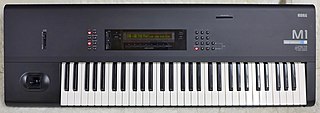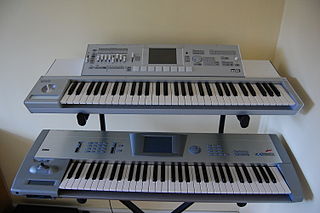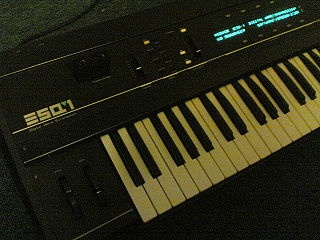Wavetable synthesis is a sound synthesis technique used to create quasi-periodic waveforms often used in the production of musical tones or notes.

The Korg M1 is a synthesizer and music workstation manufactured by Korg from 1988 to 1995. According to Sound on Sound, it is one of the bestselling synthesizers, selling an estimated 250,000 units.

The Roland D-50 is a synthesizer produced by Roland and released in April 1987. Its features include subtractive synthesis, on-board effects, a joystick for data manipulation, and an analog synthesis-styled layout design. The external Roland PG-1000 (1987–1990) programmer could also be attached to the D-50 for more complex manipulation of its sounds. It was also produced in a rack-mount variant design, the D-550 (1987–1990), with almost 450 user-adjustable parameters.
A rompler is an electronic musical instrument that plays pre-fabricated sounds based on audio samples. The term rompler is a blend of the terms ROM and sampler. In contrast to samplers, romplers do not record audio. Both may have additional sound editing features, such as layering several waveforms and modulation with ADSR envelopes, filters and LFOs.

The Korg Triton is a music workstation synthesizer, featuring digital sampling and sequencing, released in 1999. It uses Korg's HI Synthesis tone generator and was eventually available in several model variants with numerous upgrade options. The Triton became renowned as a benchmark of keyboard technology, and has been widely featured in music videos and live concerts. At the NAMM 2007, Korg announced the Korg M3 as its successor.

Ensoniq ESQ-1 is a 61-key, velocity sensitive, eight-note polyphonic and multitimbral synthesizer released by Ensoniq in 1985. It was marketed as a "digital wave synthesizer" but was an early Music Workstation. Although its voice generation is typically subtractive in much the same fashion as most analog synthesizers that preceded it, its oscillators are neither voltage nor "digitally controlled", but true digital oscillators, provided by a custom Ensoniq wavetable chip. The signal path includes analog resonant low-pass filters and an analog amplifier.
The Yamaha AN1x is a DSP-based analog modeling synthesizer, produced by Yamaha Corporation from 1997 to 1998, and was marketed as an "analog physical modelling control synthesizer".

The Korg OASYS is a workstation synthesizer released in early 2005, 1 year after the successful Korg Triton Extreme. Unlike the Triton series, the OASYS uses a custom Linux operating system that was designed to be arbitrarily expandable via software updates, with its functionality limited only by the PC-like hardware.

The microKORG is a MIDI-capable digital synthesizer/vocoder from Korg featuring DSP-based analog modelling. The synthesizer is built in such a way that it is essentially a Korg MS-2000 with a programmable step arpeggiator, a less advanced vocoder, lack of motion sequencing, lack of an XLR microphone input, and in a smaller case with fewer real-time control knobs.

The Korg DW-8000 synthesizer is an eight-voice polyphonic hybrid digital-analog synthesizer 61-note keyboard instrument released in 1985. By the time of its launch, Korg had already begun a common trend in 1980s synthesizer design: using numerical codes to access or change parameters with its predecessor - the Korg Poly-61, which was widely regarded as the company's first "knobless" synthesizer. This was a move away from the heavily laden, complex control panels of earlier designs.

Palm Products GmbH was a manufacturer of audio synthesizers. Founded and owned by Wolfgang Palm, PPG was located in Hamburg, Germany and, for 12 years from around 1975 to 1987, manufactured an acclaimed and eclectic range of electronic musical instruments, all designed by Palm.
The KORG Poly-61(PS-61) is an analogue programmable polyphonic synthesizer released by Korg in 1982, as a successor to the Polysix. It was notable for being Korg's first largely "knobless" synthesizer - featuring a push-button interface for programming, dispensing with the Polysix's knobs and switches. The Poly-61 also uses digitally-controlled analog oscillators or DCOs, in place of the Polysix's VCOs. The Poly-61 also boasted double the patch memory, but did not feature its predecessor's onboard effects.

The Korg MS2000 is a virtual analog synthesizer produced by the Japanese electronic musical instrument manufacturer Korg.
The Ensoniq TS-10 was a synthesizer and music workstation introduced by Ensoniq in 1993. It provided synthesis, user sample playback, sequencer, effect units and performance facilities in a 61-key package.

Vector Synthesis is a type of audio synthesis introduced by Sequential Circuits in the Prophet VS synthesizer during 1986. The concept was subsequently used by Yamaha in the SY22/TG33 and similar instruments and by Korg in the Wavestation.

A synthesizer is an electronic musical instrument that generates audio signals. Synthesizers typically create sounds by generating waveforms through methods including subtractive synthesis, additive synthesis and frequency modulation synthesis. These sounds may be altered by components such as filters, which cut or boost frequencies; envelopes, which control articulation, or how notes begin and end; and low-frequency oscillators, which modulate parameters such as pitch, volume, or filter characteristics affecting timbre. Synthesizers are typically played with keyboards or controlled by sequencers, software or other instruments and may be synchronized to other equipment via MIDI.

The Evolver is an analog-digital hybrid synthesizer designed by Dave Smith and manufactured by Dave Smith Instruments. It was first released as a desktop version in 2002, then later a 37-key keyboard bearing the same synth engine as the Evolver desktop was also released. A polyphonic version of the Evolver, dubbed the Poly Evolver, was released in 2004 as a rackmount version, then a 61-key keyboard version of the Poly Evolver was released in 2005. The Evolvers were replaced by new high end models, the Prophet 12 and the Pro 2.
Casio's SDSynthesizers were a late-1980s line of analog synthesizers featuring a resonant filter. SD synthesis was traditional DCO-analog synthesis, with the main difference being that some of the SD waveforms' harmonic spectrums changed temporally, or dynamically in relation to the amplitude envelope.

The Korg RADIAS is a virtual analog synthesizer and Vocoder, released by Korg in 2006. The RADIAS' MMT engine was based on the Korg OASYS synthesizer module, providing for several different synthesis methods, two of which may be combined in a single voice e.g. phase distortion synthesis can be combined with subtractive synthesis. The different synthesis methods employed by MMT represent the majority of methods used historically in other Korg synthesizers: digital waveguide synthesis Korg first used in the Korg Z1 and phase distortion synthesis was first used in the Korg DS-8. This flexibility allows for very realistic emulations of past Korg synthesizers, though stays away from trying to emulate the Korg M1 and the Korg Wavestation,. As well as using the in-built waveforms for the basis of sound creation, the RADIAS allows for the input of an external signal which may be routed through the various sound shaping devices. The RADIAS has a comprehensive matrix modulation specification and to further enhance a sound the 'Wave Shaper' module allows for various sound distortion effects.


















